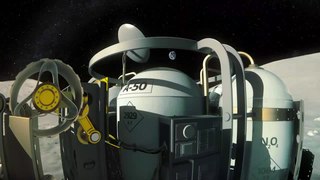Related Research Articles

Harrison Hagan Schmitt is an American geologist, retired NASA astronaut, university professor, former U.S. senator from New Mexico, and the most recent living person—and only person without a background in military aviation—to have walked on the Moon.

The Moon is Earth's only natural satellite. It orbits at an average distance of 384,400 km (238,900 mi), about 30 times Earth's diameter. The Moon always presents the same side to Earth, because gravitational pull has locked its rotation to the planet. This results in the lunar day of 29.5 Earth days matching the lunar month. The Moon's gravitational pull – and to a lesser extent the Sun's – are the main drivers of the tides.

Lunokhod was a series of Soviet robotic lunar rovers designed to land on the Moon between 1969 and 1977. Lunokhod 1 was the first roving remote-controlled robot to land on an extraterrestrial body.

A micrometeoroid is a tiny meteoroid: a small particle of rock in space, usually weighing less than a gram. A micrometeorite is such a particle that survives passage through Earth's atmosphere and reaches Earth's surface.

Edgar Dean Mitchell was a United States Navy officer and aviator, test pilot, aeronautical engineer, ufologist, and NASA astronaut. As the Lunar Module Pilot of Apollo 14 in 1971 he spent nine hours working on the lunar surface in the Fra Mauro Highlands region, and was the sixth person to walk on the Moon.
Xenoarchaeology, a branch of xenology dealing with extraterrestrial cultures, is a hypothetical form of archaeology that exists mainly in works of science fiction. The field is concerned with the study of the material remains to reconstruct and interpret past life-ways of alien civilizations. Xenoarchaeology is not currently practiced by mainstream archaeologists due to the current lack of any material for the discipline to study.

Tranquility Base is the site on the Moon where, in July 1969, humans landed and walked on a celestial body other than Earth for the first time. On July 20, 1969, Apollo 11 crewmembers Neil Armstrong and Buzz Aldrin landed their Apollo Lunar Module Eagle at approximately 20:17:40 UTC. Armstrong exited the spacecraft six hours and 39 minutes after touchdown, followed 19 minutes later by Aldrin. The astronauts spent two hours and 31 minutes examining and photographing the lunar surface, setting up several scientific experiment packages, and collecting 47.5 pounds (21.5 kg) of dirt and rock samples for return to Earth. They lifted off the surface on July 21 at 17:54 UTC.

In astronomy, lunar orbit is the orbit of an object around the Moon.

A moonbase is a facility on or below the surface of the Moon, enabling human activity on the Moon. As such, it is different from a lunar space station in orbit around the Moon, like the planned Lunar Gateway of the Artemis program. Moonbases can be for robotic or human use, in both cases not necessarily including lunar habitation facilities.

The Google Lunar XPRIZE (GLXP) was a 2007–2018 inducement prize space competition organized by the X Prize Foundation, and sponsored by Google. The challenge called for privately funded teams to be the first to land a lunar rover on the Moon, travel 500 meters, and transmit back to Earth high-definition video and images.

In archaeology, space archaeology is the research-based study of various human-made items found in space, their interpretation as clues to the adventures humanity has experienced in space, and their preservation as cultural heritage.

Lunar tourism may be possible in the future if trips to the Moon are made available to a private audience. Some space tourism startup companies are planning to offer tourism on or around the Moon, and estimate this to be possible sometime between 2023 and 2043.

The Moon bears substantial natural resources which could be exploited in the future. Potential lunar resources may encompass processable materials such as volatiles and minerals, along with geologic structures such as lava tubes that, together, might enable lunar habitation. The use of resources on the Moon may provide a means of reducing the cost and risk of lunar exploration and beyond.
References
- ↑ A Wealth Of Underwater Archaeological Sites: A Heritage In Danger (PDF). UNESCO. 2014-10-08.
- ↑ Harrowfield, David L. (2005). "Archaeology on Ice: A Review of Historical Archaeology in Antarctica". New Zealand Journal of Archaeology. pp. 5–8.
{{cite web}}: Missing or empty|url=(help) - ↑ Hammond, Norman (2008-02-26). "Antarctic May Hold Future Of Archaeology". London Times. Retrieved 2014-12-19.
- ↑ Capelotti, P. J. (2004). "Space: The Final [Archaeological] Frontier". Archaeology. Archaeological Institute of America. 7 (6). Retrieved 2014-12-19.
- ↑ "Abandoned Hektor Whaling- Station on Deception Island". abandonedplaygrounds.com. Retrieved 2014-12-19.
- ↑ "SS Republic Shipwreck". odysseysvirtualmuseum.com. Retrieved 2016-01-10.
- ↑ "Insider - Profiteers on the High Seas - Archaeology Magazine Archive". archive.archaeology.org. Retrieved 2016-01-10.
- ↑ Gibson, Ralph (2001). Lunar Archaeology: the Application of Federal Historic Preservation Law to the Site Where Humans First Set Foot Upon the Moon (M.A.). Las Cruces, New Mexico: New Mexico State University. OCLC 49321891.
- ↑ "(registration form for) Primary Record: Apollo 11 Lunar Landing Site on the Moon" (PDF). 2010-01-30. Retrieved 2014-12-20.